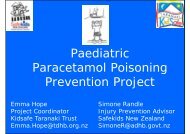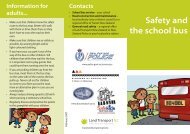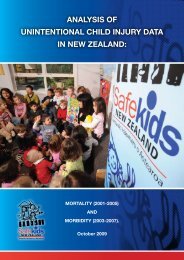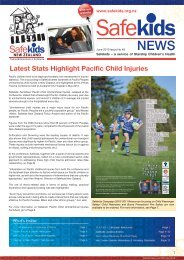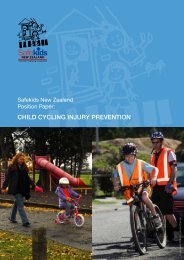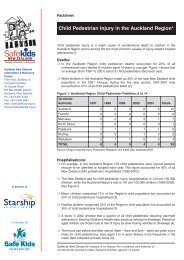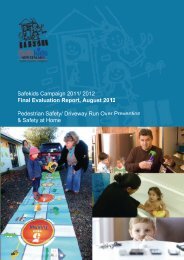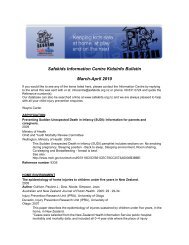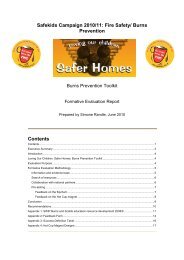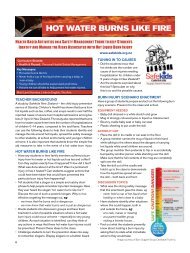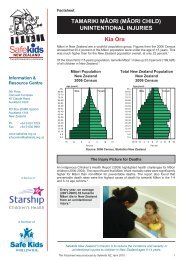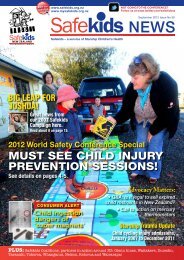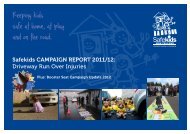Summary It's booster seat time for Kiwi kids - Safekids
Summary It's booster seat time for Kiwi kids - Safekids
Summary It's booster seat time for Kiwi kids - Safekids
You also want an ePaper? Increase the reach of your titles
YUMPU automatically turns print PDFs into web optimized ePapers that Google loves.
Appendices<br />
Appendix one: Example of child car restraint and <strong>booster</strong> <strong>seat</strong> transition criteria<br />
Product Size Range Transition Criteria Age Criteria<br />
Rearward facing<br />
Zero to nine months<br />
capsule<br />
Forward facing<br />
child <strong>seat</strong><br />
Booster<br />
Until child too<br />
long <strong>for</strong><br />
capsule (70<br />
cen<strong>time</strong>tres)<br />
Eight –<br />
eighteen<br />
kilograms<br />
Eighteen<br />
kilograms plus<br />
eye level above<br />
back of<br />
restraint or<br />
shoulders too<br />
wide<br />
Adult <strong>seat</strong> belt Height > 145<br />
cen<strong>time</strong>tres<br />
(and meet belt<br />
fit guidelines)<br />
Baby is too long to fit in capsule<br />
or weighs more than nine to<br />
twelve kilograms. If using rearfacing<br />
convertible restraint, keep<br />
rear facing as long as possible<br />
(up to twelve months).<br />
Child’s eye level is above the top<br />
of the back of the child <strong>seat</strong>,<br />
shoulders are above the top set<br />
of shoulder strap slots or when<br />
child weighs more than eighteen<br />
kilograms.<br />
When the child can achieve a<br />
good <strong>seat</strong> belt fit without the<br />
<strong>booster</strong> i.e. child’s legs are long<br />
enough to have their back firmly<br />
against the <strong>seat</strong>, and their legs<br />
bent in front of the <strong>seat</strong> cushion.<br />
This ensures the <strong>seat</strong> belt fits<br />
across the hip bones, and not<br />
over the soft abdomen. Usually,<br />
this is about 145 cen<strong>time</strong>tres tall<br />
and the sash (shoulder strap)<br />
passes across the centre of the<br />
shoulder, NOT across the<br />
bottom or side of the neck<br />
Nine months – four<br />
years<br />
Five years – at least<br />
eight years<br />
Australian Road Rules 7 th Amendment Package 2007; Prince of Wales Medical Research<br />
Institute.<br />
Appendix two: Booster <strong>seat</strong> legislation around the world<br />
Many countries have legislated <strong>for</strong> <strong>booster</strong> <strong>seat</strong> use to ensure older children are more<br />
effectively protected in the event of a car crash.<br />
Australia: Regulations <strong>for</strong> restraint of children have been reviewed; changes approved by the<br />
Federal Government and are to be implemented by each State. Once implemented, children<br />
will need to be in a dedicated child <strong>seat</strong> or infant restraint (each with a built-in harness) up to<br />
four years of age and a <strong>booster</strong> <strong>seat</strong> will be required up to seven years of age. As part of this<br />
package the Australian Standards <strong>for</strong> child restraints are being revised to cater <strong>for</strong> older,<br />
larger children in <strong>booster</strong> <strong>seat</strong>s [20].<br />
Britain: Since September 2006 United Kingdom Governments have required the compulsory<br />
use of <strong>booster</strong> <strong>seat</strong>s <strong>for</strong> children aged over five and younger than twelve years. The Actual<br />
wording is 135cm or twelfth birthday whichever comes first, but the British RoSPA website <strong>for</strong><br />
parents suggests “…it is better to keep them in the <strong>booster</strong> <strong>seat</strong> or cushion until they have<br />
reached 150cm tall”.<br />
Canada: Transport Canada publishes national child restraint recommendations which include<br />
advice <strong>for</strong> families to use <strong>booster</strong> <strong>seat</strong>s from 18kg (40lb) generally from age four and a half to<br />
eight years. Canadian Provinces have individual traffic jurisdictions and many have begun<br />
Safe<strong>kids</strong> New Zealand 2008 13



